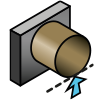Model attributes (Water Overlay): Difference between revisions
Jump to navigation
Jump to search
(Created page with "The water model calculations rely on a number of calculation-wide parameters. These parameters are available as attributes of the water overlay and can be modified as such. {...") |
No edit summary |
||
| (116 intermediate revisions by 7 users not shown) | |||
| Line 1: | Line 1: | ||
The | The [[Water Overlay]]'s model calculations depend on a number of calculation-wide parameters. These parameters are available as attributes of the water overlay and can be modified as such. | ||
{| | {{overlay attributes|suppresscategory=true|allowselflinks=true| | ||
{{:Allowed water increase m (Water Overlay)}} | |||
{{:Avg shore width m (Water Overlay)}} | |||
{{:Avg terrain width m (Water Overlay)}} | |||
| | {{:Avg terrain storage m (Water Overlay)}} | ||
{{:Breach measurement distance m (Water Overlay)}} | |||
{{:Bridge elevation (Water Overlay)}} | |||
{{:Culvert dem threshold m (Water Overlay)}} | |||
{{:Design flood elevation m (Water Overlay)}} | |||
{{:Extended reconstruction (Water Overlay)}} | |||
{{:Ground bottom distance m (Water Overlay)}} | |||
{{:Ground bottom pressure m (Water Overlay)}} | |||
{{:Ground water (Water Overlay)}} | |||
{{:Ground water depth m (Water Overlay)}} | |||
{{:Ground watertable with surface (Water Overlay)}} | |||
{{:Hydraulic conductivity with thickness (Water Overlay)}} | |||
{{:Impact flood threshold m (Water Overlay)}} | |||
{{:Impact range m (Water Overlay)}} | |||
{{:Increased resolution (Water Overlay)}} | |||
{{:Infiltration factor s (Water Overlay)}} | |||
{{:Limit area model attribute (Water Overlay)}} | |||
{{:Limit rain (Water Overlay)}} | |||
{{:Max infiltration m (Water Overlay)}} | |||
{{:Max water bottom m (Water Overlay)}} | |||
{{:Microrelief storage fraction (Water Overlay)}} | |||
{{:min max elevation (Water Overlay)}} | |||
{{:Object entry correction (Water Overlay)}} | |||
{{:Prequel surface level relative (Water Overlay)}} | |||
{{:Rise rate distance m (Water Overlay)}} | |||
{{:Sewer overflow threshold (Water Overlay)}} | |||
{{:Shoreline (Water Overlay)}} | |||
{{:Show duration flood level m (Water Overlay)}} | |||
{{:Stabilizer angle (Water Overlay)}} | |||
{{:Start date ms (Water Overlay)}} | |||
{{:Surface water (Water Overlay)}} | |||
{{:Surface water evaporation factor (Water Overlay)}} | |||
{{:Timeframe times (Water Overlay)}} | |||
{{:Timeframes (Water Overlay)}} | |||
{{:Unsaturated fraction (Water Overlay)}} | |||
{{:Weir dam multiplier (Water Overlay)}} | |||
{{:Weir move interval s (Water Overlay)}} | |||
{{:Weir move step m (Water Overlay)}} | |||
{{:Weir move range m (Water Overlay)}} | |||
}} | |||
{{WaterOverlay model attribute nav}} | |||
[[Category:Water Module]] | |||
Latest revision as of 09:23, 24 January 2024
The Water Overlay's model calculations depend on a number of calculation-wide parameters. These parameters are available as attributes of the water overlay and can be modified as such.
| Icon | Attribute | Unit | Range | Description | Default value |
|---|---|---|---|---|---|
| |
ALLOWED_WATER_INCREASE_M | m | The amount by which the water level on a water terrain must increase before it is considered stressed by water. This is used to compute the WATER_STRESS result type. | 0.4 | |
| |
AVG_SHORE_WIDTH_M | m | 0 to 10000 grid cells | With the surface water mode set to Grid Averaging, identified water average areas can be extended to include nearby shorelines within the configured distance. | 3 |
| |
AVG_TERRAIN_WIDTH_M | m | 0 to 10000 grid cells | With the surface water mode set to Avg Terrain, identified water average areas can be extended to include surrounding terrain within the configured distance. | 1000 |
| |
AVG_TERRAIN_STORAGE_M | m | 0 to 10000 | When determining the water level of a land cell that will be averaged, the level will ignore the part that is reserved for storage. | 0,05 |
| |
BREACH_MEASUREMENT_DISTANCE_M | m | Distance from the breach area to the automatically placed measurement point for the downstream water level of the breach, in the direction of the breach. | 100 | |
| |
BRIDGE_ELEVATION | nominal | 0 to 2 | Specifies the mode by which bridges are include in the elevation model, used for the water calculations. | Lowest |
| CULVERT_DEM_THRESHOLD_M | m | 0 to 10000 | The maximum distance a culvert's height can be below the terrain, for the terrain height to be adjusted to the threshold of the culvert. | 10 | |
| |
DESIGN_FLOOD_ELEVATION_M | m | Buildings in the model are assumed to have at most this height compared to the surface of the terrain. Greater values can create a more accurate model but will impact performance. | 1 | |
| |
EXTENDED_RECONSTRUCTION | boolean | 0 or 1 | When selected, a well-balanced reconstruction method for drying and wetting fronts described by Bollermann et. al. is used. This approach is useful when interested in a lake at rest situation and is applied to shorelines. When water flow is more important, this option should be unchecked. | 1 |
| |
GROUND_BOTTOM_DISTANCE_M | m | 0 to 10000 | Assumed distance under the surface terrain where the bottom boundary is situated. | 10 |
| |
GROUND_BOTTOM_PRESSURE_M | m | Optional: The additional head of higher areas outside the project causing water to flow in or out of the ground from deeper ground layers through the bottom boundary. | 0 | |
| GROUND_WATER | nominal value | Whether and how water in the ground is simulated during the calculation. | Infiltration Only | ||
| |
GROUND_WATER_DEPTH_M | m | -10000 to 10000 | The default depth of ground water in meters. | 1 |
| |
GROUND_WATERTABLE_WITH_SURFACE | boolean | Whether the ground watertable result type should also include the surface water level, when the groundwater levels are close to the surface. | True | |
| |
HYDRAULIC_CONDUCTIVITY_WITH_THICKNESS | boolean | When selected, the Terrain value HYDRAULIC_CONDUCTIVITY_WITH_THICKNESS_MD is used for horizontal groundwater flow calculations, otherwise HYDRAULIC_CONDUCTIVITY_MD is used. | 0 | |
| |
IMPACT_FLOOD_THRESHOLD_M | m | The amount of water a Building must experience before it is considered impacted by water. | 0,1 | |
| |
IMPACT_RANGE_M | m | the width in meters of the water next to or against the building that have to be flooded before the building is considered impacted by water. | 3 | |
 |
INCREASED_RESOLUTION | boolean | Load the DEM at twice the resolution. | False | |
| |
INFILTRATION_FACTOR_S | factor | -10 to 10 | This value is multiplied with the surface infiltration speed and can be used to adjust the infiltration over time. Default is 1 (no adjustment). | 1 |
| |
LIMIT_AREA | nominal value | Whether and how calculations in the simulation should be limited to specific locations of the project area. | 0 (Entire map) | |
 |
LIMIT_RAIN | nominal value | Whether rainfall can be overridden by rainfall defined in rain areas across the project area. | 0 (Entire map) | |
| |
MAX_INFILTRATION_M | m | Assumed maximum amount of infiltrated water that can be stored in the ground layer. | 1 | |
 |
MAX_WATER_BOTTOM_M | m + datum | The maximum height for the bottoms of water terrains. Any water terrain with a bottom at a higher datum height has its bottom lowered to this value. | 10000 | |
| |
MICRORELIEF_STORAGE_FRACTION | fraction (m/m) | 0.0 to 1.0 | Storage Fraction defines how much space is between Microrelief hills that can be used to store water. Setting this value to zero disables the Microrelief functionality all together. | 1.0 |
| |
MIN_MAX_ELEVATION | boolean | Whether to use highest and lowest elevations found for a grid cell for land and water respectively when interpreting the elevation model. | 1.0 | |
 |
OBJECT_ENTRY_CORRECTION | cells | 0 to 3 cells | How many cells allowed to move a hydraulic structure's entry point when it overlaps with another hydraulic building. | 2 |
| |
PREQUEL_SURFACE_LEVEL_RELATIVE | boolean | Whether the SURFACE_LEVEL prequel is considered relative instead of a datum height. | 0 | |
| |
RISE_RATE_DISTANCE_M | m | 0 to 10000 | The water height threshold for computing the Flood rise rate result type. | 1.5 |
 |
SEWER_OVERFLOW_THRESHOLD | fraction (m/m) | 0 to 1 | How much of a sewer's storage must be filled with water before the sewer overflows are allowed to overflow water. | 0.9 |
| |
SHORELINE | boolean | Whether to automatically fill cells near a water terrain when there is a mismatch between the extend of the water terrain and the DEM. | True | |
| |
SHOW_DURATION_FLOOD_LEVEL_M | m | -10000 to 10000 | The amount of water which must be exceeded in a specific location before the duration of surface water can be recorded. This is used to compute the SURFACE_DURATION result type. | 0 |
| |
STABILIZER_ANGLE | angle (0-90°) | 0 to 90 | A partly flooded cell (especially at the edges of waterways) can become unstable when the angles in X and Y direction are too far apart. In this case the fluxes in U and V cannot easily be resolved mathematically while preserving balance. To prevent unrealistic fluxes from appearing, only the flux in the primary direction will be preserved. A stabilizer angle of zero means that all cells can be considered partly flooded cells, while an angle of 90 degrees will disable the stabilizer. | 10 |
| START_DATE_MS | long | The date and time which is considered the starting moment of the simulation. | 0 | ||
| SURFACE_WATER | Nominal value | Whether and how water on the surface is simulated during the calculation. | Shallow | ||
| |
SURFACE_WATER_EVAPORATION_FACTOR | factor | 0 to 10 | The factor by which the weather evaporation factor is multiplied to compute the amount of evaporation which takes place on the surface. | 1.3 |
 |
TIMEFRAME_TIMES | integer | 0 to | The time of individual timeframes in seconds relative to the start date of the simulation. | 0 |
 |
TIMEFRAMES | integer | 1 to 1000 | The number of intermediate results recorded during the calculation. Each timeframe becomes a snapshot of data which can be viewed and analysed. | 10 |
| |
UNSATURATED_FRACTION | fraction | The initial fraction of the maximum storage capacity of the unsaturated zone which is filled with water. | 0 | |
 |
WEIR_DAM_MULTIPLIER | factor | The width with which the weir's dam should be generated perpendicular to it's direction, relative to its flow width. | 3 | |
| |
WEIR_MOVE_INTERVAL_S | seconds | 0 to 3.4028235E38 | Interval between Weir height adjustments in seconds. The Weir moves up/down to reach the target upstream water level. | 10 |
| |
WEIR_MOVE_STEP_M | m | When the move interval has passed the Weir height is adjusted up/down by this step distance in meters. | 0.01 | |
| |
WEIR_MOVE_RANGE_M | seconds | 0 to 3.4028235E38 | When the Weir height is adjusted up/down it is clamped by this value in meters. | 0.5 |




